I recently switched from a small group practice to Kaiser when the rates for my old healthcare plan went up. My first visit to my new doctor was like something out of a happy-healthcare utopia: a farmer’s market out front hawked fresh peaches and plums; bright light streamed through tall windows as I found my way to a well-marked suite; a receptionist cheerily informed me there was no copay for this welcome visit.

The startling site of the industrial-strength scale brought home to me the severity of America’s obesity epidemic, and we are passing this problem on to our children to the extent that the First Lady Michelle Obama and the Surgeon General have both made childhood obesity one of their key public platforms.
The stats keep rolling in:
- One out of three children born in 2000 are projected to become diabetic in their lifetime.
- Heart disease risk factors now occur in one out of six children school-age kids.
Attendees at the Sixth Biennial Childhood Obesity Conference, convening this week in San Diego (June 28-30), will dig deep into the problems … and possible solutions.
Hot topics will include the newly released dietary guidelines: just last month the United States Department of Agriculture retired the pyramid in favor of a plate.
Patricia Crawford, a Cooperative Extension specialist and director of the UC Berkeley-based Atkins Center for Weight and Health (CWH), a co-sponsor of the conference, said the new guidelines are geared more towards obesity prevention, whereas in the past the focus was on making sure there were no nutrition gaps.
“The plate is very similar to one developed by California Cooperative Extension,” said Crawford. “California was an early adopter — along with New York City, the American Cancer Institute, Canada, and others."
Crawford said Cooperative Extension specialists and advisors tailored the plate concept to different ethnic groups.
“We realized early on that that the plate was a valuable teaching tool,” Crawford said.
The conference will also focus on the problem of junk-food advertisements targeting kids.
“Just last month the Federal Trade Commission came out with voluntary guidelines for industry,” said Crawford. "Public health advocates pushed for monitoring to see the degree to which marketing efforts change. This voluntary approach gives the industry a chance to change on their own before it’s mandated.”
Schools are taking the issue seriously, and California has been a leader for many years. Back in 2003 there was an unfunded mandate to replace profit-making junk food with better meals. Nothing happened.

The finding? Surprise: most schools — over 80 percent — made more money when they got rid of those foods.
“It turned out that most money came from snacks. When kids quit buying junk, they moved to buying school meals, subsidized by the school meal program — and the profits came. In 2005 Governor Schwarzenegger signed legislation to limit high-sugar, high-fat snack foods in K-12 schools.
Crawford says more than half the states now have this type of legislation limiting these “competitive foods.”
Other hot topics in San Diego will be:
- Are all calories created equal? Studies say quality matters as much as quantity.
- National policy: Speakers address the Obama administration's unprecedented investment in prevention, and how it can be effective.
- Sugar-loaded beverages: National experts will be talking about newest research on how the sweet stuff is contributing to obesity.
Conference attendees can be inspired by findings that all the work in California is beginning to have an impact.
In a recently published article, the CWH showed that California is slowing the overall rate of childhood obesity. Crawford notes that legislation in 2005 to limit sugars and fats in school lunches correlates directly with the time that rates began to go down. The changes were slight, but significant.
“An individual losing a half pound at Weight Watchers may not be news, but when it comes to populations, a tiny shift indicates a tremendous public health impact,” Crawford said.
However, she notes that the disparities are more pronounced: certain groups are going down, and other high-risk groups rates are going up.
“We are beginning to have some traction, but we need to keep it up,” Crawford said.
In addition to the Atkins Center, the conference is co-sponsored by the California Department of Public Health, the University of California, Berkeley, the California Endowment, and Kaiser Permanente.
Attached Images:

More information about the Childhood Obesity Conference is at http://www.childhood-obesity.net/.